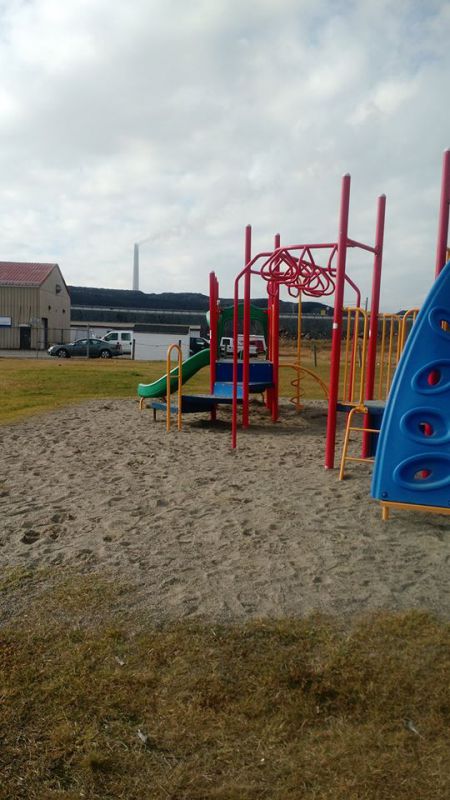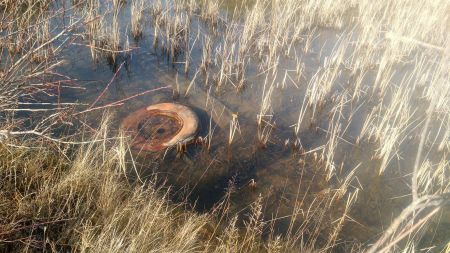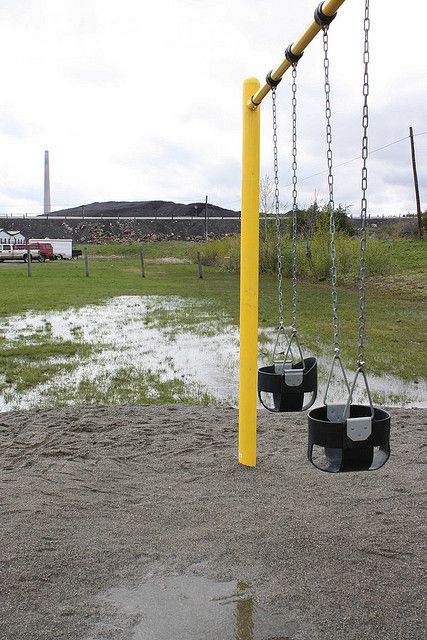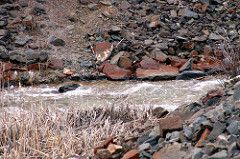What’s your reaction when you see your neighbourhood playground in the news in relation to contaminated run-off from mining slag piles? “We just moved in August from 3 houses down from the site. Kids played there all the time. A little pissed off right now that nobody alerted us to the problem.” “I lived near there for 20 yrs. ..they knew all that time and didn't inform anyone. Our kids played at that park since it was built.” “Who is going to test my soil, who is going to give us answers?” These are a few of the comments posted by residents in response to the news that Vale runoff saturated school board property in the West End, the site of Travers playground, for years. Residents have received no information from regulatory agencies, authorities, or Vale.
Let’s look at the information available so far.
In 2012, an independent study found that water from the slag storage area was seeping onto the property at a rate of 324,000 litres a day. Samples taken that same year showed that runoff at the property contained nickel 305 times above the regulated limit. The property had been saturated with contaminated run-off since at least 1988, and possibly since 1963. Run-off ends up in Nolin Creek, which feeds into Junction Creek. The Environment Canada enforcement officer has said he had reasonable grounds to suspect the company knew it was leaking contaminants into waterways since 1997. Sometime in 2012, the seepage collection was upgraded and since that time the run-off has been directed to a wastewater treatment plant before being released. Travers playground was established in 2008. New sand was brought in around the play structure, but soil in the rest of the park was not replaced. The maximum distance from the playground to the back of the property closest to the slag storage area can be estimated as 150m. There is a marshy area and wet ditches adjacent to the park.
So here are some questions that need answering when it comes to Travers Park.
- What area of the park was saturated, including during spring flooding? Where were and are children playing?
- What is the level of contamination in the soil around the playground?
- What is the level of contamination in the marshy area and ditches, and in the dust that may blow in the air when these areas become drier in the summer?
- What are the associated risks, and what remediation may be necessary?
- Which agencies are responsible for answering these questions?
It is not only the area around Travers Park that is impacted. This investigation began when a concerned citizen reported a lime green substance flowing in an unnamed creek behind Hickory Street into Nolin Creek, about 100m from Beatty Park, a well used trail along Nolin Creek in the Donovan. Samples from the creek found Nickel levels 68 times higher than allowed limits. Samples of the substance killed 100% of fish in 24 hours.
What is the level of contamination in the sediment and creek bank soil? What seepage was there into underground water? More questions we need answers to.
And here’s some more.
Environment Canada and Ontario’s Ministry of Environment and Climate Change, Vale, and others knew about this situation. What was their legal and ethical responsibility to inform residents? What procedures are in place to ensure public health is protected? This investigation centres on impacts on fish and charges laid through the Fisheries Act. However, public health must also be considered, and the information brought to light raises red flags that should not be ignored.
Two residential areas. Two City parks. Saturated soil, a marshy area, a ditch, and a creek where kids play, because that’s what kids do. We do not know the level of contamination at these locations. What we do know is reasonable grounds to use the precautionary principle, and quickly assess and remediate what risk there is. 324,000 litres a day saturating soil with run-off 305 times above the regulated limit for Nickel, on property shared with a City Park. A substance deemed ‘acutely lethal’ to fish reported in a creek running through another City Park. If these are not grounds to assess risk, remediate, and to keep residents informed and included, what is?
To date, no agency has viewed the situation as a possible public health risk. No soil samples have been taken to assess metal levels. No follow up has been done on information presented by Environment Canada in their warrant that suggests the contamination may have happened for decades. No information has been shared with residents of the area, although the Sudbury District Health Unit has recently indicated a public meeting may be held if warranted, to address residents’ concerns.
At high levels, Nickel has recognized health risks. According to the Sudbury Soil Study, the presence of high levels of Nickel can be accompanied by high levels of lead due to smelting operations. This has particularly concerning health risks for children and toddlers who are crawling around and putting hands and toys in their mouths. Exposure can occur through direct contact, ingestion, and inhalation of dust.
Environment Canada and the Ministry of the Environment and Climate Change (MOECC) should immediately assess the risks at these sites, do what remediation is required, communicate clearly to residents, and engage them openly and inclusively in what steps are needed. Residents can call the Sudbury District office of the MOECC at 705-564-3237. Leadership from the Sudbury and District Health Unit and the City is also called for.
In the meantime, concerned residents can take some easy precautionary steps to mitigate risks to their family. They can avoid the areas, or limit contact with soil, mud, or blowing dust. After playing at these parks, they can ensure young children do not put dirty hands and/or toys in their mouths. Care should be taken so that children do not handle food with dirty hands. Once at home, kids and pets who do get dirty in these parks should be cleaned, and any dirt which has been brought into the house quickly vacuumed from carpets and floors, to protect other children in the home.
These families should not have to wait any longer for answers, and for appropriate action.
======================================================
Timeline
- 1929: The slag storage area in question has been in use since 1929 and contains more than 115 million tonnes of smelter waste (4).
- 1963: In the search warrant, Gordon Moore, an enforcement officer with Environment Canada in 2012, stated the seepage may have been occurring as far back as 1963. This was based on old aerial photographs (2).
- 1988: Denis Faucher manager of facility services for the Sudbury Catholic District School Board (retired in 2013) , observed coloured runoff coming down from the nearby slag piles since at least 1988. He stated the ground surrounding the facility services building was often saturated (1,2).
- 1997: Moore alleged in the search warrant that Inco (at the time) became aware of the seepage from the slag pile as early as July 31, 1997, based on a number of internal reports from the company (1).
"I have reasonable grounds to believe Vale had knowledge of the seepage discharge, as previously described, and had failed to take action to address the seepage discharge until a direction was issued," wrote Moore (2).
- 2008: Travers playground was established. New sand was brought in around the playground at that time (SDHU, pers comm).
- October 28, 2012: A concerned citizen reported a lime green substance flowing in an unnamed creek behind Hickory Street into Nolin Creek to the provincial Spills Action Centre (2b).
Ontario Ministry of the Environment and Climate Change (MOECC) and Environment Canada became aware of the situation, and investigated. MOECC did not judge there to be a risk to public health. Therefore they did not contact the Sudbury District Health Unit (SDHU) about the situation (MOECC, pers comm).
- Nov. 8, 2012: Moore gave verbal direction to Vale to stop the deposit of the deleterious substance. (2b)
- Nov.19, 2012 : Vale submitted two applications to the MOECC related to the follow up actions needed: a permit to take water and an environmental compliance approval (pers comm MOECC).
- Nov. 20: Moore received sample results. Moore says in the warrant that tests on the substance found in the creek in October 2012 showed it killed all fish in the test within 24 hours. To be considered "deleterious" — or harmful under the Fisheries Act — a sample has to kill at least 50 per cent of fish within 96 hours (2b).
Samples from the runoff at the school board property contained nickel 305 times above the regulated limit.
Samples taken in Nolin Creek, where the green runoff was first identified, showed nickel levels to be 68 times higher than allowed and copper levels 2.6 times higher (1).
- 2012: The warrant states that a study done in 2012 for Vale by independent environmental consultant, Water Earth Science Associates, found that water was seeping onto the school board property during dry times at a rate of 45 litres per minute in one area, and 180 litres a minute in another for a total of 324,000 litres a day (2).
- Nov. 27, 2012: Moore gave written direction to Vale to stop the deposit of the deleterious substance.
Environment Canada became aware that MOECC had the 2 applications from Vale (2b).
- 2012: Vale put temporary pumps in place in low lying areas to direct the seepage to the Nolin treatment plant; then put in a permanent solution directing run-off to the wastewater treatment plant before being released into Nolin Creek. The MOECC does not have the exact dates these happened, but feel that the situation was addressed quickly. The solution implemented is working as required (pers comm, MOECC).
- Dec. 18, 2012: Environment Canada learns that MOECC has approved the permits (2b).
- Oct. 8, 2015: Environment Canada issues search warrant to search Sudbury’s Vale offices for evidence (1). Information is taken from Vale offices for investigation by Environment Canada and RCMP (3).
- 2015: Charges are laid by police against Vale under the Fisheries Act for actions on or about Oct. 28, 2012: release of effluent into Nolin Creek with Nickel levels higher than prescribed (deposit of deleterious substances in water frequented by fish); failure to report the incident; and failure to provide a proper written report (2b).
Further information
- No soil tests have been done as a result. To date, there has been no information shared with residents from these areas.
- Nolin Creek is not connected to drinking water sources.
- Canadian Council of Ministers of the Environment guidelines for Nickel (5):
- water quality for protection of aquatic life: 25 micrograms per litre
- soil quality for protection of environmental and human health, residential or parkland, or agricultural: 45 mg/kg dry weight
- For information on the health impacts of Nickel and the basis for the guidelines for the protection of environmental and human health, see the Canadian Soil Quality Guidelines for the Protection of Environmental and Human Health, Nickel 2015, Fact Sheet (6).
- The Sudbury and District Health Unit, the City, and the Ontario Ministry of Climate Change and the Environment have stated that there is no reason for concern (1, pers comm SDHU and MOECC).
- In general: “The Sudbury & District Health Unit has stated that no precautions are necessary when using Greater Sudbury Parks. The City of Greater Sudbury supports this statement. The concentrations of metals and arsenic measured in the Sudbury area are similar to those found at other mining and smelting sites around Ontario where previous risk assessments have found no adverse health risks” (7).
==
1. Vale runoff saturated school board property for years. Northern Life. Nov. 2, 2015
2. Vale under probe for alleged toxic Sudbury, Ont. smelter run-off. CBC. Oct. 23, 2015.
2b. Portions of warrant and charges available with this story.
3. Police raid Vale office in Sudbury. Sudbury Star. October 9, 2015.
4. What about the People? Place, Memory, and Industrial Pollution in Sudbury. Stacey Zembrzycki. November 5, 2015.
5. Canadian Council of Ministers of the Environment guidelines for Nickel (2015)




